Leccinum holopus (Rostk.) Watling - Ghost Bolete
Phylum: Basidiomycota - Class: Agaricomycetes - Order: Boletales - Family: Boletaceae
Distribution - Taxonomic History - Etymology - Identification - Culinary Notes - Reference Sources
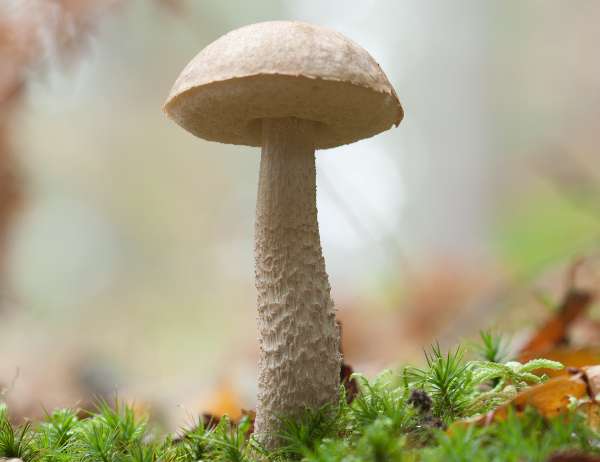
Appearing under birch trees, sometimes together with the Brown Birch Bolete Leccinum scabrum, Leccinum holopus is commonly known as the Ghost Bolete. Its whitish form is most distinctive.
Formerly considered to be separate species, Leccinum olivaceosum and Leccinum aerugineum are now generally considered to be merely forms of Leccinum holopus. Leccinum nucatum is also considered by many authorities to be synonymous with Leccinum holopus.
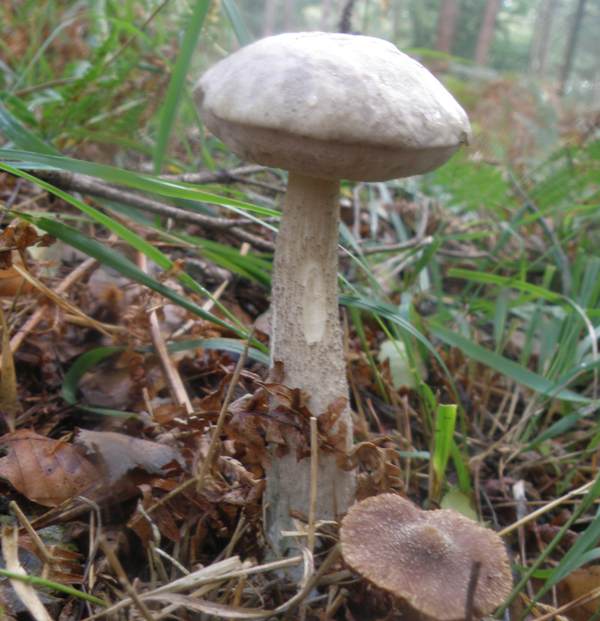
Distribution
A rare find in most areas but nevertheless widely distributed in Britain and Ireland, the Ghost Bolete occurs throughout most of mainland Europe, from Scandinavia right down to Portugal, Spain and Italy provided there are birch trees present. (Above: old specimens, central France.)
Leccinum holopus has also been recorded from many parts of North America.
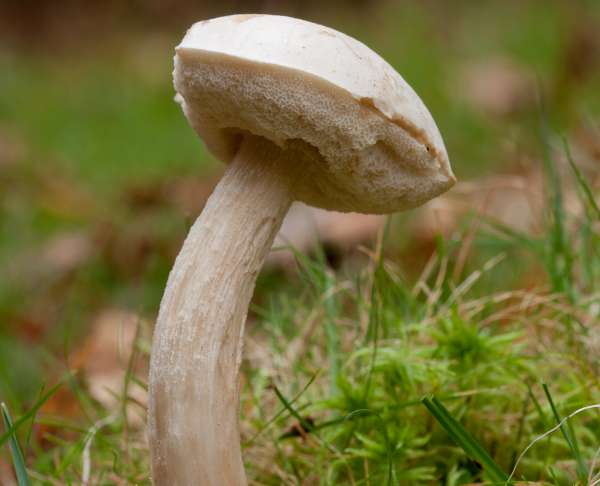
Taxonomic history
The Ghost Bolete was described in 1844 by German mycologists Friedrich Wilhelm Gottfried Theophil Rostkovius (1770 - 1848), who gave it the binomial scientific name Boletus holopus. The currently-accepted scientific name Leccinum holopus dates from a 1960 paper by British mycologist Roy Watling, published in the Transactions of the British Mycological Society.
Synonyms of Leccinum holopus include Boletus holopus Rostk., Leccinum holopus var. americanum A.H. Sm. & Thiers, Krombholziella holopus (Rostk.) Šutara, Leccinum nucatum Lannoy & Estadès, and Leccinum olivaceosum Lannoy & Estadès.
Etymology
Leccinum, the generic name, is derived from an old Italian word meaning fungus. The specific epithet holopus comprises the prefix holo- meaning whole or entire, and the suffix -pus meaning foot, stalk (stem) or base.
Identification guide
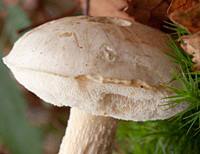 |
CapSmaller than many Leccinum mushrooms, the cap diameter ranges between 4 and 9cm in diameter when fully expanded, remaining broadly convex rather than flattening out completely. When moist the cap surface is tacky or slightly greasy, drying to dull matt or very finely fleecy. The most common form of the Ghost Bolete, which has a smallish (usually 4 to 7cm) white or off-white cap, grows under birch trees in boggy soil almost invariably with sphagnum moss. A biscuit-brown or greenish form, typically more robust and with a cap diameter up to 9cm, occurs in wet birch woodlands. |
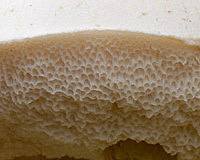 |
Tubes and PoresThe creamy-white tubes terminate in pores typically 0.5mm in diameter that are also creamy white, often with yellow-brown spots. The pores turn slowly brownish when they are bruised. |
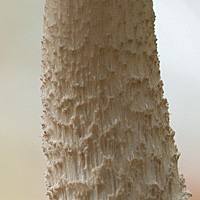 |
StemThe stipe or stem is 4-12cm tall and typically 2 to 4cm in diameter, tapering in slightly towards the apex, has a white, pale grey or yellowish-grey surface covered with dark brown or blackish woolly scales. When cut, the pale stem flesh may either remain whitish throughout or turn blue-green near to the stem base. |
SporesFusiform, smooth, thin-walled,15.5-18 x 5.5-7µm, inamyloid. Spore printOchraceous buff to reddish brown. Note: Other microscopic characters may have to be examined before a specimen can be conclusively recorded as Leccinum holopus. Of particular significance are the caulocystidia and the hyphal structure of the pileipellis. (I'll add photomicrographs of these features one day... meanwhile I recommend the key by Geoffrey Kibby - see the References section, below.) |
|
Odour/taste |
Not distinctive. |
Habitat & Ecological role |
Mycorrhizal, beneath birch mainly on wet acidic heathland, woodland edges and scrub. |
Season |
July to September in Britain and Ireland. |
Similar species |
Leccinum scabrum, which also occurs under birch, usually has a brown cap but is occasionally yellowish brown; its stem flesh does not usually display a marked colour change when it is cut, although occasionally it turns pinkish red. |
Culinary Notes
Leccinum holopus is generally considered to be a good edible mushroom and in places where it is plentiful this bolete is sometimes used in recipes that call for Ceps Boletus edulis (although in both flavour and texture a Cep is superior). Alternatively, use Ghost Boletes to make up the required quantity if you do not have sufficient Ceps. Across most of Britain and Ireland the Ghost Bolete is a rare find, making its collection for anything other than serious scientific research quite inappropriate.
Reference Sources
Pat O'Reilly, Fascinated by Fungi, 2016.
Henk C. den Bakker, Barbara Gravendeel & Thomas W. Kuyper (2004). An ITS phylogeny of Leccinum and an analysis of the evolution of minisatellite-like sequences within ITS1; Mycologia, 96(1), 2004, pp. 102-118.
British Boletes, with keys to species, Geoffrey Kibby (self published) 3rd Edition 2012.
Dictionary of the Fungi; Paul M. Kirk, Paul F. Cannon, David W. Minter and J. A. Stalpers; CABI, 2008
Taxonomic history and synonym information on these pages is drawn from many sources but in particular from the British Mycological Society's GB Checklist of Fungi.
Acknowledgements
This page includes pictures kindly contributed by David Kelly.
Fascinated by Fungi. Back by popular demand, Pat O'Reilly's best-selling 450-page hardback book is available now. The latest second edition was republished with a sparkling new cover design in September 2022 by Coch-y-Bonddu Books. Full details and copies are available from the publisher's online bookshop...

